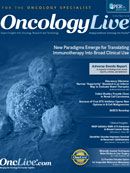Publication
Article
Oncology Live®
Ibrutinib Represents "Transformative" Approach in CLL Treatment
Author(s):
Jennifer R. Brown, MD, PhD, and John Byrd, MD, are leading researchers in the emerging field of Bruton tyrosine kinase (BTK) inhibition in chronic lymphocytic leukemia (CLL) and other B-cell malignancies.
Jennifer R. Brown, MD, PhD
Jennifer R. Brown, MD, PhD, and John Byrd, MD, leading researchers in the emerging field of Bruton tyrosine kinase (BTK) inhibition in chronic lymphocytic leukemia (CLL) and other B-cell malignancies, discussed key questions involving their research in separate interviews with OncologyLive.
Please briefly describe your research interests as they relate to BTK in cancer.
Brown: I am a clinical/translational researcher specializing in CLL. The B-cell receptor pathway mediated through BTK is constitutively activated in CLL, and this has made BTK an excellent target for clinical inhibition in CLL. The importance of BTK to B-cell biology is also evident in the fact that the human disease X-linked agammaglobulinemia results from defects in BTK.
Byrd: Our laboratory and clinical effort is focused on the biology of B-cell neoplasia and molecular pharmacology. BTK comes forward as an outstanding target for B-cell diseases as it does not produce a significant phenotype in knockout mouse models or people outside of B cells. It also has several functions that are relevant in B cells that have not been explored.
Can you discuss the emerging data showing the efficacy of ibrutinib in CLL?
Brown: Early studies of ibrutinib in CLL have shown high response rates but in particular excellent durability of remission. For example, in 85 relapsed/refractory CLL patients with a median of four prior therapies, the progressionfree survival (PFS) is 75% at approximately 2-year follow-up. In 31 older patients given single-agent ibrutinib as up-front therapy, the PFS is 96%—with only 1 patient event. Thus, the activity is excellent.
In addition, Pharmacyclics recently announced that the randomized registration trial RESONATE, which compared ibrutinib with ofatumumab in relapsed CLL patients, was stopped early because it met its primary endpoint of PFS, as well as the key secondary endpoint of overall survival.
John C. Byrd, MD
Byrd: Ibrutinib is a transformative drug for CLL where patients can be treated with an oral agent for extended periods of time without relapse or toxicity that has been observed to date. It has newly identified immune-modulating potential, which may, in part, explain the dramatic efficacy. As we move forward to upfront therapy of CLL, it is potentially possible that we will see a pattern of treatment emerge that is similar to chronic myeloid leukemia (CML) today where patients remain on chronic oral therapy for an extended period of time. This is particularly true for elderly patients and those with other comorbidities. This agent truly is a patientfriendly therapy.
In which other cancer types does ibrutinib show the most significant promise?
Brown: The data in mantle cell lymphoma are very strong, and those data led to the initial approval by the FDA in November 2013. In addition, a Breakthrough Therapy designation was given for ibrutinib in Waldenström’s macroglobulinemia, where activity is also very impressive. In diffuse large B-cell lymphoma (DLBCL), activity looks promising in the ABC subtype.
Byrd: Ibrutinib has been effective across a wide range of B-cell lymphomas including follicular lymphoma, mantle cell lymphoma, monocytoid B-cell lymphoma, DLBCL, and Waldenström. The best data emerge from the lower-grade non- Hodgkin lymphoma. It is now being explored in multiple myeloma, graft-versus-host disease, and many other diseases. I see its greatest potential as an immune-modulating agent based upon its ability to inhibit a kinase called ITK. This polarizes T cells to potentially fight cancer and infection, as well.
How do other BTK-targeting agents in development compare with ibrutinib?
Brown: Two other agents are in phase I clinical trials that were recently updated at ASH, and these are CC-292 and ONO-4059. Both are also covalent inhibitors of BTK that bind to the same cysteine residue, but CC-292 in particular is more specific than ibrutinib for BTK. CC-292 is furthest along and appears safe and efficacious at the recommended phase II dose, but we do not yet know about its durability. ONO-4059 also looks promising in dose escalation studies but patient numbers are thus far limited and follow-up is short.
Byrd: The only other BTK inhibitor with sufficient data to infer this is AVL-292 [now CC-292] and this agent does not look as good. This very well may be a defect in the drug and not the target. Other second- generation molecules are coming forward that do look quite good and this has the potential to make the field very similar to CML where we have several tyrosine kinase inhibitors that can really help patients.
What are the most significant unanswered questions relating to BTK signaling and the use of BTK inhibitors for the treatment of cancer?
Brown: Key questions are going to relate to the mechanisms of resistance, and how those will influence our decisions about whether to use BTK inhibitors sequentially or in combination with other novel agents. So far, some early reports suggest that mutations of the target cysteine in BTK are a cause of relapse, so it is plausible that dual pathway inhibition with another targeted agent might suppress the development of such clones. In addition, we will need to determine if BTK- independent clones may grow out as a mechanism of resistance.
Byrd: Among the most significant questions are: What is the role of tumor microenvironment versus direct tumor effect? What are the mechanisms of resistance and how can we overcome these and also prevent this from happening? Who are the patients at risk for unusual toxicities from BTK inhibitors? What are the immune-modulating effects of BTK inhibitors and is this predominantly on the BTK or ITK target? How do we combine these in a rational way to cure CLL and other diseases?










